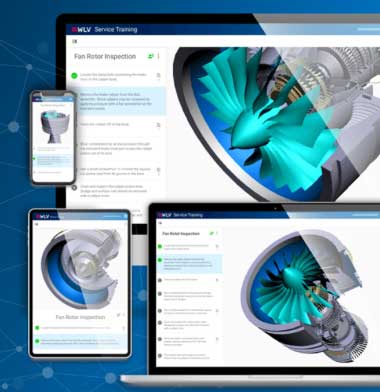
Vertex Software is a visualization platform for 3D-powered digital twin applications. Image courtesy of Vertex Software.
Latest News
March 17, 2021
Vertex Software, a visualization platform for 3D-powered digital twin applications, reports that the U.S. Patent and Trademark Office issued U.S. Pat. No. 10,950,044, titled, “Methods and apparatus to facilitate 3D object visualization and manipulation across multiple devices.” This is a comprehensive patent that covers the core of the Vertex platform. It is the first of an extensive portfolio that is under development.
“We have solved a longstanding problem in our industry that no other company has been able to address in decades, and we did so by thinking differently and building something nobody thought possible,” says Dan Murray, founder and CEO of Vertex. “To have our creativity recognized by the USPTO is a source of pride for the entire Vertex team and should be very comforting for our customers, partners and investors.”
Vertex’s patent describes a distributed computing method for interactive visualization of 3D models at scale. Specifically, Vertex has invented a low-cost approach for remote 3D rendering that is based upon the subdivision of 3D models, spatial indexing of geometric primitives, and a scalable fan-out/fan-in architectural computing pattern. Vertex’s architecture is built on four tenants:
Sharding subdivides 3D models into equally sized sets of geometric primitives based upon spatial proximity. The shard datastore accommodates a large number of concurrent users rendering massive 3D models simultaneously. This makes the platform extremely responsive. Sharding also forms the cornerstone of the data security model.
Spatial indexing of shards provides for rapid lookup of shards needed to render a 3D scene.
Rapid view frustum culling uses spatial indices to determine the jobs to be performed by the fan-out process. This supports fast and affordable rendering by reducing the scope of 3D shards to be rendered for a given scene.
High-speed laminate compositing assembles 3D images generated concurrently by a large network of CPU-based workers during the fan-in process. The resulting image is delivered to the end user device at a high frame rate to provide fluid interactivity and responsiveness for the end user.
The manifestation of this patent is the Vertex 3D Visualization Platform, a cloud-native digital twin platform that makes it easy to build and deploy low-code industry 4.0 applications. The Vertex platform runs on CPUs making it the most cost-effective approach for remote 3D rendering available.
By rendering 100% of the 3D data in the cloud, Vertex securely delivers fully interactive digital twin experiences to any device, anywhere—instantly. This approach solves for the lack of specialized hardware and tools for distributed teams and customers outside of engineering.
Vertex customers—including category-leading Fortune 500 manufacturers—use the platform for use cases such as:
- Factory assembly instructions and defect reporting
- Field service training and service instructions
- Sales configuration reviews
- Engineering design reviews and supply chain collaboration
Sources: Press materials received from the company and additional information gleaned from the company’s website.
Subscribe to our FREE magazine, FREE email newsletters or both!
Latest News
About the Author
DE’s editors contribute news and new product announcements to Digital Engineering.
Press releases may be sent to them via DE-Editors@digitaleng.news.




